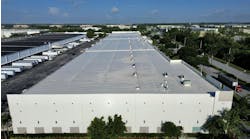Roofing insulation doesn’t get much respect. Out of sight and out of mind describes the approach of many commercial building owners and facility managers. If the roof system doesn’t have a hole (keep those fingers crossed), then all is good. But roof insulation affects your building’s performance and operations cost – not to mention its service life – on a nearly daily basis.
Roof insulation affects your building’s performance and operations cost.
Related: Is a Vegetative Roof Right for Your Building?
As many as 90% of roofs on commercial buildings consist of low-slope designs with rigid insulation attached to a deck of steel or concrete. In these systems the insulation can play three roles:
1. Thermal barrier
2. Drainage
3. Working platform
Maximizing each role of the roofing insulation increases your roof’s ROI.
Breaking Down Roofing Insulation’s Thermal Function
Heat moves through a roof in three ways. Each has a different impact on building performance and the options available to control it.
- Conduction occurs within solid materials and between solid materials in physical contact. This is perhaps the most intuitive path of heat transfer.
- Convection occurs within gases and liquids as a combined result of heat conduction within the gas or liquid and the movement of these substances. For insulation, that means air gaps, entrapped or latent moisture (evident in all construction materials) and wind uplift/negative pressure.
- Radiation occurs independently of solids, gases and liquids, such as when sunlight heats a roof or heat radiates outward from a building at night.
Read also: 3 Tips for Daylighting Integration
The figure (below) “Controlling Heat Transfer” summarizes strategies for controlling each type of heat transfer.
For conduction, the unit R-value of the insulation and the total R-value of the complete roof assembly should be increased.* To increase unit R-value, the amount and choice of insulation are the key factors. All other things being even, more insulation means more R-value. However, different materials offer different R-values.
“Unit R-Value” shows the R-value of various roofing insulation types. Polyiso and extruded polystyrene (XPS) offer the highest thermal values per inch.
To increase the total R-value of an assembly, consider each component’s R-value, as the value for each will be different. The values for each component in an assembly are additive (i.e. the sum of the values for all components is the value for the total assembly).
Any thermal “shorts” or bridging across components will need to be controlled because they will lower the assembly’s total value. Mechanical fasteners are a frequent cause of bridging. Options to control such shorts include fastening all layers in adhesive and using non-thermal-bridging fasteners. Monolithic insulations, including spray foams and lightweight concrete, can also be used to eliminate shorts.
Strategies to Control Convection
Owners have two basic strategies to eliminate the waste of convection on their roofs:
- Control air movement
- Control moisture movement and condensation
Membrane uplift from high winds and gaps in the insulation can both create air movement in a roof system, shown in “Air Movement in Roof System.”
The solution is an air barrier, which is typically required by code in ASHRAE Zone 4 and higher, or roughly north of St. Louis. Among the approved materials for such barriers are plywood, OSB, foil-faced polyiso, fully adhered single-plies, and cement and gypsum boards.
In cold climates, moisture movement tends to occur from the warm, humid interior to the cold, dry exterior. This movement allows condensation to form under the membrane. In hot climates, moisture moves from the warm, humid exterior to the cold, dry interior, forming condensation above the deck (“Moisture Movement in a Roof”).
The solution is a vapor retarder made from a material selected on its permeability (or perm) rating. Materials with adequate perms can include single-plies, polyethylene film, asphalt felt, XPS and expanded polystyrene (EPS).
Hand-picked: Break Room Ideas that Won’t Break the Bank
Your roofing professional will need to analyze your facility’s need for a vapor retarder and where it should be located in the system. Vapor barriers can trap moisture in certain climates and conditions, which can lead to unintended and costly damage to the roofing system. As a result, a professional should model the need for a vapor retarder and its location.
EnergyWise, a free online tool sponsored by the National Roofing Contractors Association (NRCA), is a simple program for this purpose. More sophisticated programs like WUFI are also available.
Promote Drainage with Your Roofing Insulation
In a case of hitting two birds with one stone, insulation can double as a drainage system. Tapered insulation boards can direct water away from walls and curbs and toward drains and gutters as seen in “Roof Drainage.”
Drainage is an option for roof retrofits as well as new construction.
To direct and drain water adequately, a roof requires a minimum ¼-inch drop over 12 inches. Because roof geometry can be complex, higher slopes may be necessary to ensure that all areas have at least the minimum slope. Computer tools make the task easier, and tapered insulation is now a widely used practice.
Ensure Your Insulation is an Adequate Working Platform
Over its lifetime, your roof and its insulation will serve as a working platform for numerous trades during construction and maintenance. The roofing insulation may require temporary protection before the roof system is completed and permanent protection after system completion.
Using cover boards over roofing insulation is an excellent practice. Other options include choosing an insulation with adequate compressive strength and installing walkways. Monitoring roof access and traffic – which trade is on the roof and when – is also important.
Even more: How Cool Roofs Can Reduce Water Use
Insulation is only one component of your roofing system, but it performs multiple functions that you can optimize for your building.
*R-value (thermal resistance) is a measure of the ability to resist heat transfer; U-value (thermal conductance) is a measure of a material or assembly to transfer heat. The two have a mathematical relationship (U = 1/R). I prefer using R-values because the numbers are larger and easier to manage, e.g., a U-value of 0.025 is equal to an R-value of 40.
Dr. Jim Hoff is President of TEGNOS Research Inc. and a consultant to the building envelope industries. His research and executive experience in building materials includes 23 years at Firestone Building Products, where he retired as Vice President of Technology. He has published numerous articles on quality management, lifecycle analysis and building system performance.


